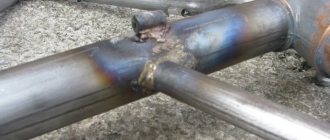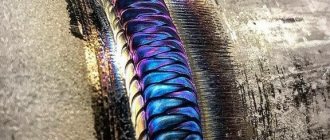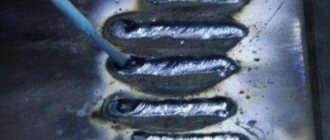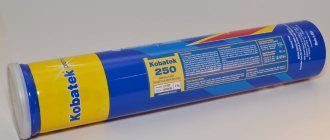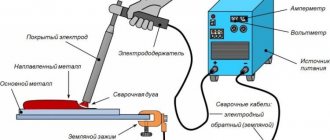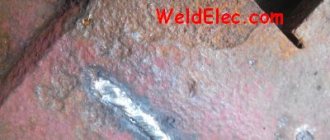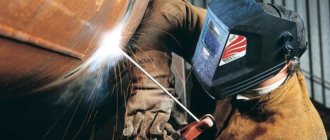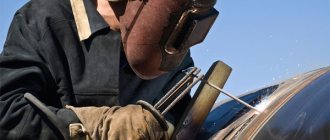In a private house, country house or garage, quite often there is a need to connect various metal parts and create structures from them. It makes no sense to turn to professionals for help every time in such a situation, because you can purchase an automatic welding machine yourself.
A wide selection of different devices are available in stores in different price categories, so welding with an inverter for beginners is the best that the market has to offer.
Basics of electric welding
Inverter devices are characterized by fairly high efficiency and ease of operation. The main load for the operation of such equipment falls on the electrical network.
It has storage capacitors that allow you to accumulate electricity and ensure an uninterrupted welding process and soft ignition of the arc.
Unlike old devices, which provide a maximum boost of electricity for work, which can result in traffic jams, an inverter allows you to safely operate from a household power supply.
Defects in welds.
To understand how to cook using inverter welding, you need to understand the basics of its operation.
In such manual welding machines, the arc is formed as a result of contact of the electrode with the product. Under the influence of temperature, the metal and electrode melt. The molten part of the rod and the product form a bath.
The coating of the rod also partially melts, turning into a gaseous state and closing the weld pool from oxygen. This allows you to protect the product from oxidation.
Each electrode, depending on its diameter, is designed for a certain current strength. If you reduce it below the required value, then the seam will not work. Increasing this parameter will allow you to form a seam, but the rod will burn out too quickly.
At the end of the welding work, the coating cools down, turning into slag. It covers the connection of metal parts from the outside. By tapping the seam with a hammer, it is quite easy to get rid of the slag.
There are also simple welding rules. To ensure that the arc does not go out during work, the welder should maintain a constant distance between the rod and the workpiece.
This is not easy to do because the electrode melts, so it must be fed into the welding zone at a constant speed. In addition, you must try to guide the electrode evenly along the joint in order to obtain a seam of maximum quality.
You can learn more about how to assemble a subwoofer with your own hands and about electronic radio circuits on the website - www.radiochipi.ru.
What defects are worth knowing about in order to make the correct welding seam?
Knowledge about welding defects is very important so that you recognize them in time and do not start operating a welded structure with an unreliable connection.
If the seam is welded correctly, it looks uniform and neat, with equal thickness and height along the entire length.
The following main defects are distinguished:
- Lack of penetration. Insufficient filling with suture material, and its strength is reduced. The reason is insufficient voltage in the circuit or excessive speed of electrode guidance.
- Undercut Longitudinal groove. Occurs due to excessive arc length. To eliminate the defect, you should choose the correct current strength and increase it slightly.
- Burns. Formation of through holes in the material. It is caused by exceeding the current required for a given material thickness, as well as by moving the electrode too slowly. It is also necessary to check whether the gap between the edges of the workpieces is not exceeded.
- Porosity. Occurs due to a draft in the work area, blowing away the cloud of protective gases.
Lack of penetration
Undercut
There are also other welding defects, such as longitudinal and transverse cracks
Welding methods
Nowadays there are many methods used for welding. They are divided according to various criteria. This information will be useful for a beginner, so you should definitely read it.
Depending on the heating, the edges of the product may completely melt or be in a plastic state. The first method also requires applying certain forces to the parts being joined - pressure welding.
In the second, the connection is formed as a result of the formation of a weld pool in which there is molten metal and an electrode.
There are other welding methods in which the product does not heat up at all - cold welding, or is not brought to a plastic state - connection using ultrasound.
Methods and types of welding.
Other types of welding are listed below:
- Forge. In this method, the ends of the joined products are heated in a forge and then forged. This method is one of the most ancient and is currently practically not used.
- Gas press. The edges of the products are heated with oxygen acetylene over the entire plane and brought to a plastic state, after which they are subjected to compression. This method is highly efficient and productive. Used in the construction of gas pipelines, railways, and mechanical engineering.
- Contact. The parts are included in the electrical circuit of the welding equipment and current is passed through them. A short circuit occurs at the point of contact of the parts, as a result of which a large amount of heat is released at the junction. It is enough to melt and join metal.
- Butt, point and suture are varieties of the contact method of fastening the product.
- Roller. Used in joining sheet structures that require high-quality and reliable seams.
- Termite. The metal is held together by burning thermite, a mixture of iron oxide powder and pure aluminum.
- Nuclear-water. The edges of the product are melted by the action of an arc burning between two tungsten electrodes. The electrodes are connected to special holders through which hydrogen is supplied. As a result, the arc and liquid metal of the weld pool are protected by hydrogen from the harmful effects of atmospheric gases such as oxygen and nitrogen.
- Gas. The essence of the method is to use a flame to heat and melt parts. A flame is produced by burning a flammable gas in an oxygen atmosphere. The gas-oxygen mixture is produced using special burners.
Under the action of an atomic-hydrogen welding arc, hydrogen molecules are split into atoms and then recombined upon contact with cold metal. As a result of this process, a large amount of heat is released. The method is used for welding metals of small thickness, copper and alloys based on it.
The gas welding method refers to fusion welding. The gaps between the products are filled using filler wire. This method is widely used in various areas of human life. Most often found when joining thin-walled products, non-ferrous metals, cast iron.
When working with an inverter device, the polarity of the electrodes is of no small importance. Depending on the scheme, the heating intensity of the part changes, which allows you to create different welding conditions.
Types of welds
Connecting welds are divided according to location, strength, technology, and design features. Types of seam locations:
- Lower. The simplest and most convenient, thanks to gravity, the metal fills the gap between the parts. This is the most durable and economical seam.
- Horizontal. The workpieces are located perpendicular to the electrode and the seam runs horizontally. Some of the metal leaves the welding zone and the electrode is consumed faster.
- Vertical. In this case, the workpieces are also located perpendicular to the electrode, but the seam is formed vertically. The molten metal tends downwards, the consumption of the electrode is significant.
- Inclined. The movement of the welder's hand occurs at an angle. Used for corner and T-joints.
- The ceiling seam is located above the master.
Separation by design:
- Butt. The butt joint is quite durable and economical; it does not distort the joint surface. This is a universal connection.
- Overlapping parts are welded when there is not enough space for a butt seam. The thickness of the workpieces should not be more than 8-10 mm.
- It is recommended to weld a corner seam on both sides, with the workpieces positioned at an angle to each other. This seam is not easy to perform due to the increase in the heat-affected zone and the high consumption of the electrode.
- A T-weld is a fillet weld where the planes of the parts are welded perpendicularly. The seam is formed on both sides and is quite complex.
- A seam for electric rivets is used when there is no need for a sealed seam; it is the most economical and inconspicuous.
Welding can be carried out either in one layer or in several layers for thick workpieces.
Step-by-step instructions for welding with an inverter
First of all, for welding you need to have protective elements:
- gloves made of rough fabric;
- welding mask with a special filter protecting the eyes;
- a rough jacket and trousers made of material that will not catch fire from sparks that appear during welding;
- closed shoes with thick soles.
Electrode position during welding.
Before you start welding with a welding inverter, you must take the necessary measures aimed at creating safe working conditions.
Proper preparation of the workplace consists of:
- ensuring the necessary free space on the table, you should remove all unnecessary objects that could get splashed;
- creating high-quality lighting;
- Welding work must be performed while standing on a wooden floor that protects against electric shock.
Then the current is adjusted depending on the thickness of the parts and the electrodes are selected. The latter need to be prepared. If they were just purchased in a retail chain and their quality is beyond doubt, then this step can be skipped.
If the rods have been in an unheated, damp room for a long time, then they need to be dried for two to three hours at a temperature of 2000 degrees. For these purposes, you can use an old oven or special equipment, if available.
After preparing the electrodes, the ground terminal is connected to the product.
To obtain a high-quality and reliable connection, the metal must be prepared:
- rust is completely removed from the edges of the product;
- using solvents, various contaminants are cleaned;
- At the last stage, the edges are checked for cleanliness; the presence of grease, paint and other contaminants is unacceptable.
Next you need to connect the welding inverter. It is better to carry out training on a thick metal sheet, forming a seam in the form of a roller. Make the first connection on metal lying horizontally on the table. Draw a straight line on it with chalk along which the seam will go.
Electrical circuit of the inverter.
In the process of training on such an object, you can significantly improve your welding technique.
The welding process begins with ignition of the arc.
There are two ways to perform this action:
- scratching on metal;
- tapping on metal.
The choice of method depends on the person’s preferences; the main thing when igniting is not to leave traces of welding outside the joint area.
After igniting the arc from contact with the metal, the arc is ignited, the welder removes the electrode from the surface of the part a short distance corresponding to the length of the arc and begins welding.
As a result, a weld is formed at the junction of two metal parts. It will be covered with scale - scale on the surface. It needs to be removed. This is very easy to do by tapping the seam with a small hammer.
What else do you need to have?
A welding machine without electrodes is a completely useless unit. Electrodes are a consumable material, they also come in different types: melting and non-melting, metal (made of steel, copper and other metals) and non-metallic, in the form of wire or a rigid rod, with different protective coatings, etc.
For those who are wondering how to properly weld with electrodes, it is best to start with steel universal rods 3 mm or 4 mm thick. The diameter is indicated on the package, it will not be difficult to choose the ones you need. Having mastered working with them, you can switch to other types, but they are unlikely to be in demand in everyday life.
Electrodes for inverter
In addition to welding consumables, you will definitely need a welder's mask. It is absolutely impossible to work without it, otherwise you can quickly get a burn to the cornea and many other vision problems. Masks with chameleon glass are considered the best. Or rather, with an automatic light filter that reacts to changes in illumination and protects the eyes from harmful radiation.
It is also advisable to acquire suitable clothing, shoes and gloves that are not burned by sparks and can protect against electric shock if something happens.
The tools you will need are a hammer to knock down scale from the seam, as well as all kinds of vices, clamps and magnetic corners that can be used to fix the parts to be welded in the desired position.
Minimum kit for a beginner welder
Forward and reverse polarity
Melting of the metal for welding occurs under the influence of an arc. It, as noted above, is formed between the surface of the product and the electrode, since they are connected to opposite terminals of the device.
There are two main options for welding, differing from each other in the order of connection and called direct and reverse polarity.
In the first case, the rod is connected to the minus, and the part to the plus. In this case, an increased flow of heat occurs into the metal. As a result, a deep and narrow melting zone is formed.
Direct and reverse polarity.
With reverse polarity, the electrode is connected to the positive, and the product to the negative. In this case, the melting zone is wide and shallow.
The choice of polarity is entirely determined by the product you are working with. Welding can be performed with two types of polarity. When choosing, you should take into account the fact that the element connected to the positive is subject to greater heating.
For example, it is difficult to weld thin metal products due to possible overheating and burning. In this case, the part is connected to the minus. Currents are also selected according to the diameter of the electrode and the thickness of the metal. This data is taken from a special table.
Effect of electrode feed speed
The feed rate of the welding electrodes must provide the required amount of molten material supplied. Not having enough of it can lead to undercutting. This factor is very important in both direct and reverse polarity when welding.
During electric arc welding, due to the rapid movement of the rod along the joint, the arc power may not be enough to heat the metal. The result is a shallow seam that lies on top of the metal. The edges remain unmelted.
Slow advance of the electrode leads to overheating. In this case, it is possible to burn the surface and deform the thin metal.
Modern welding machines have a wide range of different functions and capabilities. Nevertheless, at the moment, most of the quality work done is still determined by human skill.
Video description
All this is clearly visible in slow motion:
The slag crust from the weld is beaten off by tapping with a hammer after it has cooled.
Important nuances
The main secret of how to properly weld two parts and get an even seam is that when moving the electrode, the slag has time to cover the entire surface of the molten metal. And this depends on the speed of movement, the angle of inclination of the electrode and the trajectory of its movement. The current strength is also important.
The universal working angle is 30-60 degrees relative to the vertical. Wherein:
- moving the electrode at an angle forward (away from you), it is convenient to make any vertical, horizontal and circular seams;
- at an angle back (towards you) - weld corner joints;
- the vertical position of the electrode is allowed only when welding in hard-to-reach places;
- An angle of more than 60 degrees greatly stretches the weld pool, and the metal of the welded parts heats up worse. It is usually used when you need to trim off excess or touch up a rough seam.
The influence of the angle of inclination of the electrode on the shape of the weld pool
The welding speed is determined experimentally: it is necessary to ensure that the shape and dimensions of the weld pool remain stable and do not stretch or spread. It is very important to keep the electrode at the same distance from the surface - 3-5 mm from it. Moreover, as the bath is burned out and deepened, it must be lowered slightly, and when moving to the next section, raised again, trying not to go beyond the specified limits.
To connect the edges of two parts, you need to ensure that their particles penetrate each other. To do this, the electrode must move not in a straight line, but along a certain trajectory, oscillating from side to side. This trajectory may resemble a herringbone, ladder, figure eights, connected triangles, etc.
Options for moving the electrode tip during welding
Effect of current
Welding current selection table.
When mastering the basics of welding with an inverter, it is important to understand what current strength needs to be set in each individual situation. A properly configured inverter welding machine is the key to success.
Data on the current value are taken from the table, which also shows the size of the electrodes. However, these current values are not exact; they are plus or minus several tens of amperes.
The most basic diagram of the unit
An easy-to-assemble device, assembled with your own hands, must be connected to a network with an alternating current voltage of 220 Volts.
A voltage of 380 Volts requires a more complex welding machine design.
The simplest circuit is a circuit for the pulsed welding method, which was invented by radio amateurs. This welding is used to attach wires to a metal board.
To build this device with your own hands, you don’t need to do anything complicated, you only need a couple of wires and a choke. The choke can be removed from the fluorescent lamp.
The current regulator can easily be replaced with a fuse-link. It is better to stock up on large quantities of wires.
To connect the electrode to the board, take a choke. An alligator clip can serve as an electrode. The finished unit must be connected to the network by inserting a plug into the socket.
Using the clamp connected to the wire, you need to quickly touch the area to be welded on the board.
This is how a welding arc appears. During its occurrence, there is a danger that the fuses located in the electrical panel will burn out.
The fuses are protected from this danger by a fuse link that burns faster.
As a result, the wire remains welded to its place.
Such a direct current device is the simplest welding machine. It is connected to the electrode holder by wires.
But it seems possible to work with it only at home, since this circuit is devoid of important parts - a rectifier and a current regulator.
Features of welding thin metal
In everyday tasks, we are most often faced with the need to join thin metal. In this case, it is necessary to remember the basics of inverter welding for beginners, namely the importance of connecting the product to the correct pole. Thin parts are connected to the “minus” of the welding machine.
To learn how to weld correctly and get beautiful seams, you need to practice.
Here are some useful tips that can help improve your skills:
- start cooking using the minimum current;
- form the seam at an angle forward;
- use reverse polarity;
- secure the part to reduce distortion during welding.
Preparation for welding
When setting the goal of learning how to properly arc weld, you should understand that the safety and effectiveness of welding largely depends on the preparatory process. You should start welding work only after preparing the welding machine:
- it is necessary to check the frequency of the electric current and voltage, the readings in the working device and in the network must be the same;
- The electrode number must be selected taking into account the power of the equipment;
- The grounding terminal must be securely fixed;
- check all connections, integrity of cable insulation;
- Place the electrode in the holder and check the strength of its fixation.
You also need to prepare the surface to be welded. It must be thoroughly cleaned of rust, traces of oil and other contaminants. If this is not done, the weld seam will have defects.
The electrodes are also checked for integrity. It is important that the coating is free of chips and cracks. It is often necessary to first calcinate or dry the electrodes and only then insert them into the device holder.
Common mistakes made by newbies
Arc welding diagram.
Beginner welders tend to make mistakes due to ignorance of the basics regarding the use of welding equipment. For example, beginners may not know how to choose the correct polarity for welding with an inverter, which will lead to poor-quality joint formation or even burning of the part.
The following main errors can be identified:
- neglect of safety precautions;
- incorrect choice of welding machine;
- use of low-quality or unprepared electrodes;
- work without trial seams.
For beginners, it is worth separately noting one feature if you cook Resanta by welding. This equipment is very popular, but it has short connection cables, which can create inconvenience in operation.
Toroidal apparatus
It is much lighter than usual. It is convenient to carry. Such devices are used where the ability to quickly transport is important.
Whatever device you choose, in any case, make it yourself:
- Interesting;
- Practical;
- Economical.
And, of course, it’s always nice to show a homemade welding machine to your friends. It will become a source of pride and an indispensable assistant in the household.
Repairing a welding machine with your own hands is also quite exciting.
Let's sum it up
Having learned to work with welding equipment, it will be possible to solve many everyday problems that often arise when working in the country or in the garage. Beginners should pay special attention to the polarity of welding parts of different thicknesses with an inverter.
By understanding how to properly configure the equipment and choose an electrode, you will be able to obtain high-quality seams on any product. Be sure to pay attention to the forward and reverse polarity of connecting the welding inverter.
When welding thick parts, direct polarity is used when welding with an inverter, and for thin parts, reverse polarity is used.
